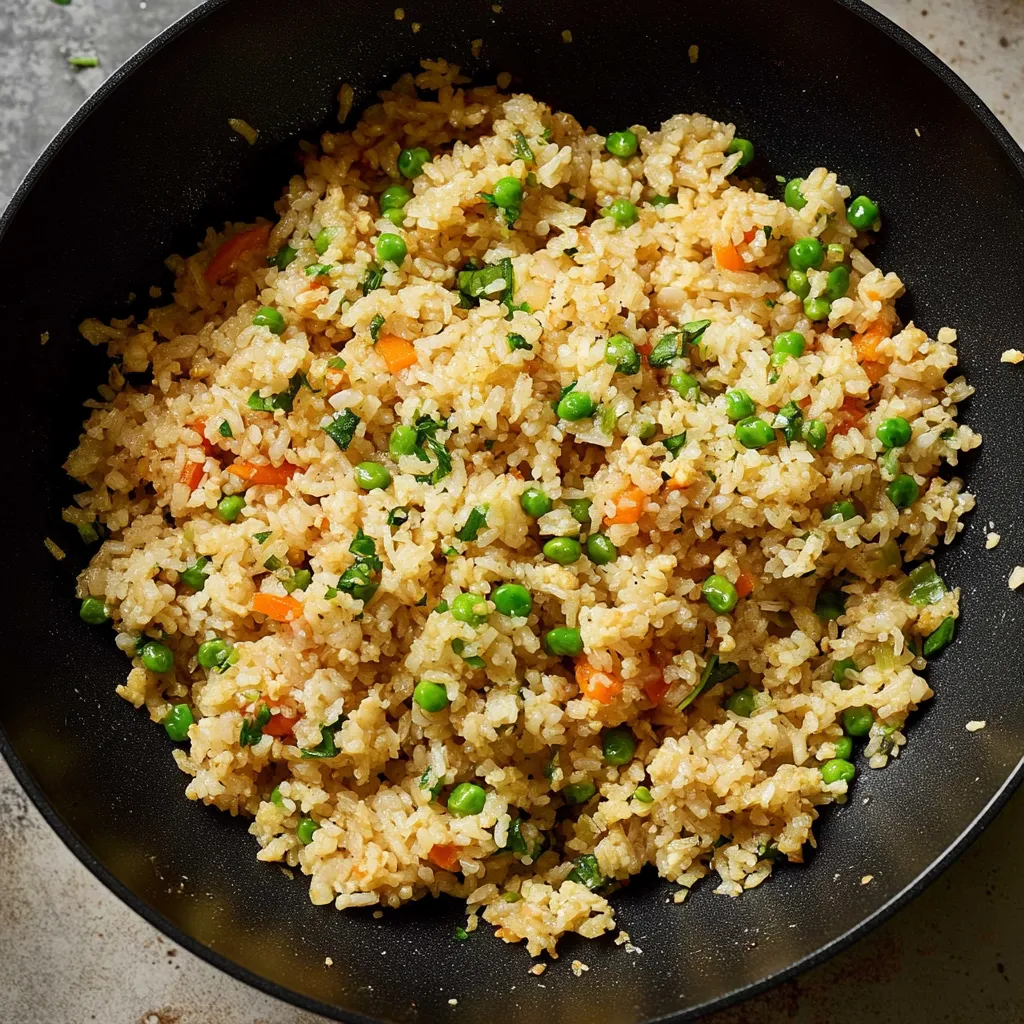 Pin it
Pin it
This simple fried rice recipe captures all the comforting flavors of your favorite Chinese takeout while using up whatever leftovers you have in your refrigerator. The key to exceptional fried rice lies in using day-old rice that's been properly dried out, which prevents the grains from clumping together and creates that perfect separate, fluffy texture that makes each bite satisfying. Unlike complicated stir-fry dishes that require precise timing and multiple pans, this one-pan method lets you build flavors gradually while scrambling eggs right alongside the rice for maximum efficiency and authentic taste.
Growing up, fried rice was always our family's solution for using up leftovers in the most delicious way possible. My mom would transform whatever remained from dinner the night before into something that tasted completely new and exciting. Now I use the same approach with my own family, and it's become one of our most requested comfort meals that never gets old.
Essential Ingredients and Selection Tips
- Day-old cooked rice: Use long-grain varieties like jasmine or basmati that have been refrigerated overnight; the cooling process dries out the grains and prevents mushiness
- Fresh eggs: Choose the freshest eggs possible for the fluffiest scrambled texture; they should have firm whites and bright yellow yolks
- Garlic: Use fresh cloves that are firm and aromatic; avoid pre-minced garlic which lacks the sharp bite needed for authentic flavor
- Scallions: Select bunches with bright green tops and firm white bottoms; both parts serve different purposes in building flavor layers
- Frozen peas and carrots: Choose brands without added sodium; frozen vegetables work better than fresh here because they don't release excess moisture
- Soy sauce: Use low-sodium soy sauce so you can control the saltiness; light soy sauce provides better color than dark varieties
- Sesame oil: This finishing oil adds authentic nutty flavor; a little goes a long way, so use it sparingly for the best results
The secret to restaurant-quality fried rice is having everything prepped and ready before you start cooking, since the actual cooking process happens very quickly over high heat.
Detailed Step-by-Step Instructions
- Step 1: Prepare the day-old rice:
- If you don't have leftover rice, cook fresh rice and spread it in a thin layer on a large sheet pan, then refrigerate for at least 1 hour to cool and dry out. Break up any clumps with your hands or a fork - the grains should feel dry and separate easily from each other.
- Step 2: Prep all ingredients:
- Mince the garlic finely, separate the white and green parts of the scallions, and have your frozen peas and carrots ready. Crack the eggs into a small bowl and beat them lightly with a pinch of salt. Having everything ready is crucial since fried rice cooks very quickly.
- Step 3: Heat the cooking vessel:
- Use a large wok or non-stick frying pan and heat it over medium-high heat until very hot - a drop of water should sizzle and evaporate immediately. Add a tablespoon of neutral cooking oil and swirl to coat the bottom of the pan completely.
- Step 4: Cook the aromatics:
- Add the minced garlic and white parts of the scallions to the hot oil, stirring constantly for 30-60 seconds until fragrant but not browned. The garlic should release its aroma but not turn golden, as burned garlic will make the entire dish bitter.
- Step 5: Add the vegetables:
- Toss in the frozen peas and carrots, stirring frequently for 2-3 minutes until they're heated through and tender. The vegetables should be bright in color and just cooked through - overcooking will make them mushy and affect the final texture.
- Step 6: Incorporate the rice:
- Add the cold, separated rice to the pan and use a spatula or wooden spoon to break up any remaining clumps. Stir-fry for 3-4 minutes, tossing continuously to ensure even heating and to let each grain get coated with the flavorful oil and aromatics.
- Step 7: Season the rice:
- Drizzle soy sauce evenly over the rice mixture, starting with 2 tablespoons and adding more to taste. Toss everything together until the rice is evenly colored and seasoned. The rice should have a light golden-brown color from the soy sauce.
- Step 8: Create space and scramble eggs:
- Push all the fried rice to one side of the pan, creating an empty space on the other side. Pour the beaten eggs into this empty space and let them sit for 10-15 seconds before gently scrambling with a spatula, breaking them into small, fluffy curds.
- Step 9: Combine and finish:
- Once the eggs are just set but still slightly soft, fold them into the rice mixture, distributing them evenly throughout. Remove from heat and drizzle with sesame oil, then garnish with the chopped green scallion tops for color and fresh onion flavor.
 Pin it
Pin it
The most important technique is maintaining high heat throughout the cooking process and never stopping the motion - constant stirring prevents sticking and ensures even cooking while developing that characteristic "wok hei" flavor.
This recipe holds special meaning for me because it represents the heart of home cooking - taking simple, everyday ingredients and transforming them into something that brings the family together. There's something deeply satisfying about watching leftover rice become the foundation for a completely new meal that everyone enjoys.
Understanding Rice Science and Texture Control
The science behind why day-old rice works better for fried rice lies in the starch retrogradation process that occurs during cooling. When rice cools in the refrigerator, the starch molecules reorganize and become firmer, while surface moisture evaporates. This creates grains that hold their individual shape and don't break apart or become mushy during the high-heat stir-frying process. Fresh, hot rice contains too much moisture and the starches are still too soft, resulting in a sticky, clumpy texture rather than the desired separate grains. The cooling and drying process is essential for achieving authentic restaurant-quality texture.
Wok Techniques and Heat Management
Traditional fried rice benefits enormously from proper wok techniques, even when using a regular frying pan. The key principle is "wok hei" - the breath of the wok - which refers to the slightly smoky, charred flavor that develops from cooking over very high heat. Maintaining constant motion prevents ingredients from burning while allowing them to develop complex flavors through quick searing. The technique of pushing ingredients to one side of the pan is traditional and practical - it allows you to cook different components at different rates while keeping everything in the same vessel.
Egg Scrambling Techniques in Stir-Fries
The method of scrambling eggs directly in the pan with other ingredients is a classic Chinese cooking technique that creates perfectly distributed egg pieces without the need for separate cooking. The key is timing - the eggs should be added when the pan is hot enough to set them quickly but not so hot that they become rubbery. Gentle scrambling creates small, fluffy curds that integrate seamlessly with the rice, while aggressive stirring can break them into tiny pieces that disappear into the dish. The residual heat continues cooking the eggs even after folding them into the rice.
Customization Strategies and Flavor Building
Fried rice serves as an excellent canvas for creativity because its basic technique remains constant while ingredients can vary dramatically. Proteins like Chinese sausage, shrimp, or leftover roasted meats should generally be cooked first and set aside, then added back at the end to prevent overcooking. Vegetables with different cooking times should be added in stages - harder vegetables like carrots first, softer ones like peas later. Sauce additions like oyster sauce or hoisin should be added with or just after the soy sauce to ensure even distribution and proper heating.
Storage, Reheating, and Food Safety
Fried rice stores exceptionally well because the cooking process has already dried out excess moisture and the flavors continue to meld during storage. When reheating, add a splash of water or broth to prevent drying out, and heat thoroughly to ensure food safety. The dish can be frozen successfully for up to a month, though the texture of vegetables may change slightly. For best results when reheating, use a pan with a little oil rather than just microwaving, as this helps restore some of the original texture and prevents the rice from becoming too soft.
This fried rice recipe has taught me that some of the most satisfying cooking comes from understanding basic techniques so well that you can adapt them to whatever you have available. Every time I make it, I'm reminded that great cooking isn't about having exotic ingredients - it's about applying good technique to simple, everyday foods and creating something that brings comfort and joy to the table.
Frequently Asked Questions
- → Can I use fresh rice instead of leftover rice?
- It's better to use day-old rice that's been chilled. Fresh rice tends to get mushy when stir-fried because it has too much moisture.
- → What vegetables can I add to fried rice?
- You can use any vegetables you like - bell peppers, broccoli, corn, or mushrooms. Frozen mixed vegetables work great and save prep time.
- → How do I prevent my fried rice from getting soggy?
- Use cold, day-old rice and cook over high heat. Don't overcrowd the pan and keep everything moving quickly while stir-frying.
- → Can I make this recipe without eggs?
- Yes, you can skip the eggs or substitute with scrambled tofu for a vegan version. The rice will still taste great with just the vegetables and seasonings.
- → How long does leftover fried rice last?
- Store leftover fried rice in the fridge for up to 3 days. Reheat in a pan with a little oil or in the microwave until heated through.
